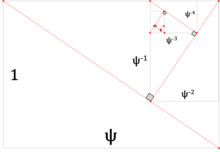Supergolden ratio
In mathematics, two quantities are in the supergolden ratio if the quotient of the larger number divided by the smaller one is equal to
| Binary | 1.01110111001011111010… |
| Decimal | 1.4655712318767680266567312… |
| Hexadecimal | 1.772FAD1EDE80B46… |
| Continued fraction | [1; 2, 6, 1, 3, 5, 4, 22, 1, 1, 4, 1, 2, 84, 1, …] Note that this continued fraction is neither finite nor periodic. (Shown in linear notation) |
| Algebraic form | |
which is the only real solution to the equation . It can also be represented using the hyperbolic cosine as:
The decimal expansion of this number begins 1.465571231876768026656731…, and the ratio is commonly represented by the Greek letter (psi). Its reciprocal is:
The supergolden ratio is also the fourth smallest Pisot number.[1]
Supergolden sequence
The supergolden sequence, also known as the Narayana's cows sequence, is a sequence where the ratio between consecutive terms approaches the supergolden ratio.[2] The first three terms are each one, and each term after that is calculated by adding the previous term and the term two places before that. The first values are 1, 1, 1, 2, 3, 4, 6, 9, 13, 19, 28, 41, 60, 88, 129, 189, 277, 406, 595…[2][3] (OEIS:A000930).
Properties

Many of the properties of the supergolden ratio are related to those of the golden ratio. For example, the nth item of Narayana's sequence is the number of ways to tile a 1×n rectangle with 1×1 and 1×3 tiles,[4][nb 1] while the nth term of the Fibonacci sequence is the number of ways to tile a 1×n rectangle with 1×1 and 1×2 tiles.[nb 2] φ−1=φ−1, and ψ−1=ψ−2. . In Fibonacci's rabbit problem, each pair breeds each cycle starting after two cycles, while in Narayana's cow problem, each pair breeds each cycle starting after three cycles.[2] There is a supergolden rectangle that has the property that if a square is removed from one side, the remaining rectangle can be divided into two supergolden rectangles of opposite orientations.[2]
Another example is that both the golden ratio and the supergolden ratio are Pisot numbers. The supergolden ratio's algebraic conjugates are and have a magnitude of , as the product of the roots of is 1.
Supergolden rectangle

A supergolden rectangle is a rectangle whose side lengths are in the supergolden ratio, i.e. that the length of the longer side divided by the length of the shorter side is equal to , the supergolden ratio ψ. When a square with the same side length as the shorter side of the rectangle is removed from one side of the rectangle, the sides resulting rectangle will be in a ψ2:1 ratio. This rectangle can be divided into rectangles with side-length ratios of ψ:1 and 1:ψ, two supergolden ratios of perpendicular orientations,[2] and their areas will be in a ψ2:1 ratio.[3] In addition, if the line that separates the two supergolden rectangles from each other is extended across the rest of the original rectangle such that it, along with the side of the square that was removed from the original rectangle, divides the original rectangle into quadrants, then the larger supergolden rectangle has the same area as the opposite quadrant,[5] its diagonal length is the length of the short side of the original rectangle divided by √ψ, the fourth quadrant is also a supergolden rectangle, and its diagonal length is √ψ times the length of the short side of the original rectangle.[3]
See also
- Solutions to equations similar to
- Golden ratio – the only positive solution to the equation
- Plastic number – the only real solution to the equation
Notes
- This is assuming that order matters. If order does not matter, then there are possible ways.
- This is assuming that order matters. If order does not matter, then there are possible ways.
References
- "OEIS-A092526". oeis.org. The OEIS Foundation Inc. 7 April 2004. p. A092526. Retrieved 15 February 2019.
- Crilly, Tony (2007). "Chapter 11–12". In Mansfield, Keith (ed.). 50 mathematical ideas you really need to know. Illustrated by Tony Crilly and Patrick Nugent; proofread by Anna Faherty (13th ed.). London: Quercus. pp. 47–51. ISBN 978-1-84724-147-4.
- Koshy, Thomas (2017). Fibonacci and Lucas Numbers with Applications (2 ed.). John Wiley & Sons. ISBN 9781118742174. Retrieved 14 August 2018.
- Sloane, Neil (7 September 2012). "A000930 - OEIS". oeis.org. The OEIS Foundation Inc. p. A000930. Retrieved 12 August 2018.
- Crilly, Tony (1994). "A Supergolden Rectangle". The Mathematical Gazette. 78 (483): 320–325. doi:10.2307/3620208. JSTOR 3620208.
